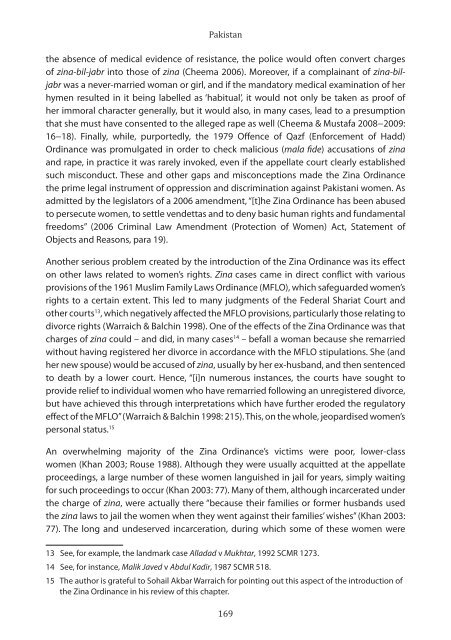control and sexuality
control and sexuality
control and sexuality
- No tags were found...
You also want an ePaper? Increase the reach of your titles
YUMPU automatically turns print PDFs into web optimized ePapers that Google loves.
Pakistanthe absence of medical evidence of resistance, the police would often convert chargesof zina-bil-jabr into those of zina (Cheema 2006). Moreover, if a complainant of zina-biljabrwas a never-married woman or girl, <strong>and</strong> if the m<strong>and</strong>atory medical examination of herhymen resulted in it being labelled as ‘habitual’, it would not only be taken as proof ofher immoral character generally, but it would also, in many cases, lead to a presumptionthat she must have consented to the alleged rape as well (Cheema & Mustafa 2008−2009:16−18). Finally, while, purportedly, the 1979 Offence of Qazf (Enforcement of Hadd)Ordinance was promulgated in order to check malicious (mala fide) accusations of zina<strong>and</strong> rape, in practice it was rarely invoked, even if the appellate court clearly establishedsuch misconduct. These <strong>and</strong> other gaps <strong>and</strong> misconceptions made the Zina Ordinancethe prime legal instrument of oppression <strong>and</strong> discrimination against Pakistani women. Asadmitted by the legislators of a 2006 amendment, “[t]he Zina Ordinance has been abusedto persecute women, to settle vendettas <strong>and</strong> to deny basic human rights <strong>and</strong> fundamentalfreedoms” (2006 Criminal Law Amendment (Protection of Women) Act, Statement ofObjects <strong>and</strong> Reasons, para 19).Another serious problem created by the introduction of the Zina Ordinance was its effecton other laws related to women’s rights. Zina cases came in direct conflict with variousprovisions of the 1961 Muslim Family Laws Ordinance (MFLO), which safeguarded women’srights to a certain extent. This led to many judgments of the Federal Shariat Court <strong>and</strong>other courts 13 , which negatively affected the MFLO provisions, particularly those relating todivorce rights (Warraich & Balchin 1998). One of the effects of the Zina Ordinance was thatcharges of zina could – <strong>and</strong> did, in many cases 14 – befall a woman because she remarriedwithout having registered her divorce in accordance with the MFLO stipulations. She (<strong>and</strong>her new spouse) would be accused of zina, usually by her ex-husb<strong>and</strong>, <strong>and</strong> then sentencedto death by a lower court. Hence, “[i]n numerous instances, the courts have sought toprovide relief to individual women who have remarried following an unregistered divorce,but have achieved this through interpretations which have further eroded the regulatoryeffect of the MFLO” (Warraich & Balchin 1998: 215). This, on the whole, jeopardised women’spersonal status. 15An overwhelming majority of the Zina Ordinance’s victims were poor, lower-classwomen (Khan 2003; Rouse 1988). Although they were usually acquitted at the appellateproceedings, a large number of these women languished in jail for years, simply waitingfor such proceedings to occur (Khan 2003: 77). Many of them, although incarcerated underthe charge of zina, were actually there “because their families or former husb<strong>and</strong>s usedthe zina laws to jail the women when they went against their families’ wishes” (Khan 2003:77). The long <strong>and</strong> undeserved incarceration, during which some of these women were13 See, for example, the l<strong>and</strong>mark case Alladad v Mukhtar, 1992 SCMR 1273.14 See, for instance, Malik Javed v Abdul Kadir, 1987 SCMR 518.15 The author is grateful to Sohail Akbar Warraich for pointing out this aspect of the introduction ofthe Zina Ordinance in his review of this chapter.169


